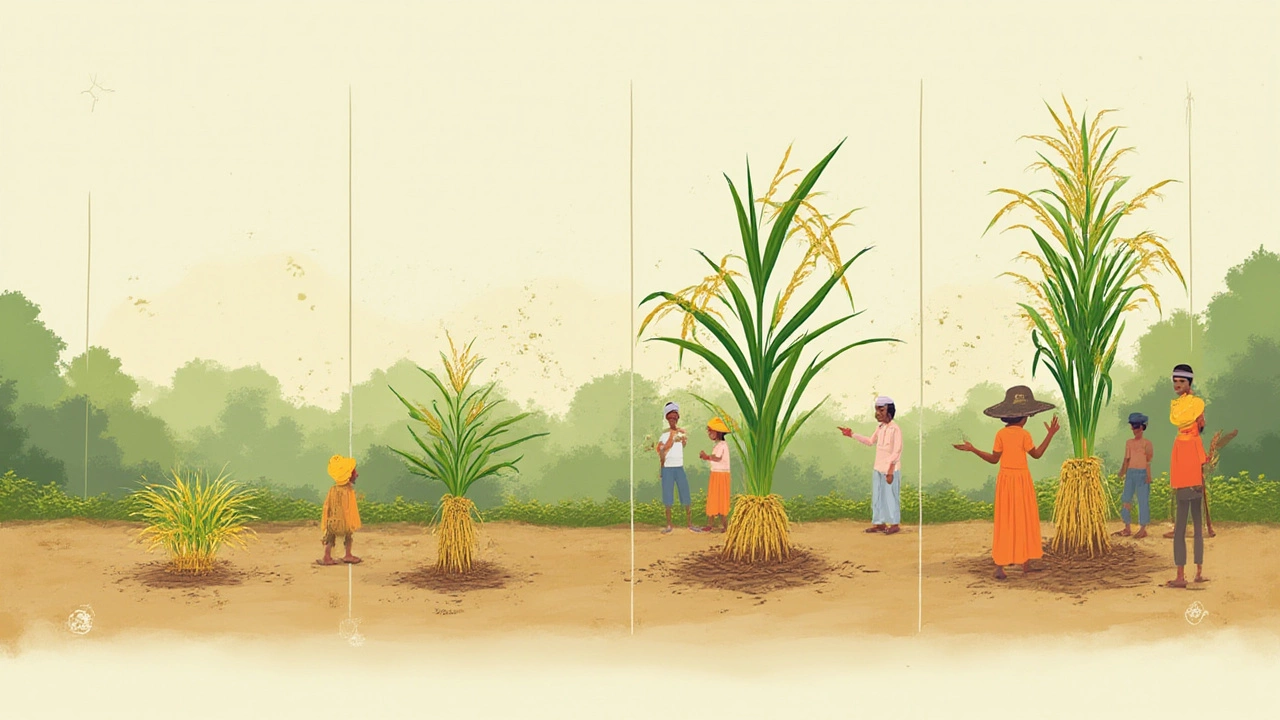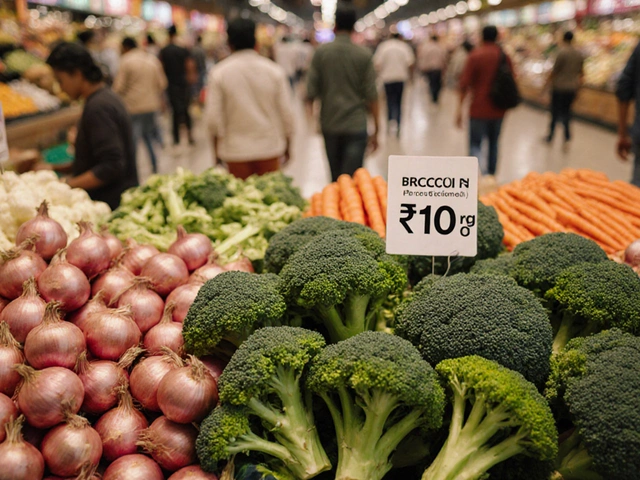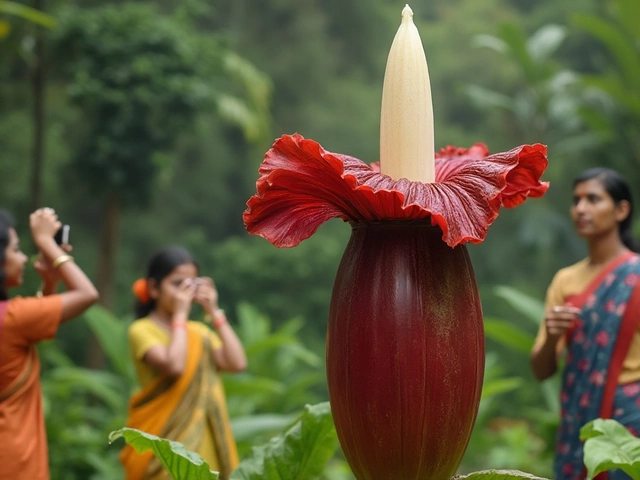You might chew through bowls of rice on autopilot and never stop to imagine the actual numbers behind that snowy mountain on your plate. But behind every spoonful, there’s a field full of green, and surprisingly, one slight rice plant can pack thousands of grains. If you’ve ever found yourself staring at a rice field or even a random rice stalk, wondering, "So how much rice actually grows from this one little plant?", you're not alone. Let’s breakdown the science, the story, and the secrets of rice yield—straight from the ground up—with details you probably haven’t heard elsewhere.
The Anatomy of a Rice Plant: More Than Meets the Eye
If you’ve ever grown rice, even as an experiment in a bucket, you’ll know it starts absurdly small. Each rice plant begins with a slender shoot—delicate, green, and honestly, kind of unimpressive. But don’t be fooled. As the weeks shuffle by, that shoot starts stacking up tillers. Let me explain, because nobody uses that word unless they’re knee-deep in a paddy. Tillers are side branches or shoots that sprout around the base of the main stem. Each tiller acts like a mini plant, and by the end of the growing season, a healthy plant usually sports 5-10 tillers, sometimes more if the conditions are top-notch.
Here’s the good part: each tiller forms a panicle—a feathery, spike-like branch where grains develop. Every panicle is a tiny bushel-bearer. Now, the exact look and output vary by variety, climate, and how much TLC the farmer puts in. Ideally, you’ll spot compact panicles loaded with little developing grains, each a future rice kernel. So instead of thinking one stalk equals a handful of rice, picture a single plant cranking out a bouquet of panicles, each with dozens or even hundreds of grains. That’s where the numbers really start to jump.
The magic behind rice yield starts way back with these tillers and panicles. Fancy breeders have spent generations selecting varieties that naturally pack in more tillers and more plump grains per panicle, making each individual plant a mini rice factory. But there’s a catch: more tillers aren’t always better unless the plant gets enough sunlight, food, and water to plump them up. Otherwise, you might get lots of panicles but they’ll be skinny and weak—like trying to build muscle without eating enough food. So yes, the inner workings of a rice plant are a ruthless balance between numbers and nurturing.
The Big Question: How Many Rice Grains Per Plant?
Alright, time for the juicy answer you probably scrolled here for. An average rice plant can produce anywhere from 70 to over 200 grains per panicle. Most varieties clock in around 100 grains per panicle. Remember, though, every plant generally grows 5-15 panicles, depending on variety, soil, climate, and care. So, math fans, multiply those numbers out: one plant can put out anywhere from 500 to 3,000 grains of rice in a single season. It might sound bonkers, but even backyard growers report harvesting roughly a cup of rice per healthy plant if they start with quality seeds, good soil, and never forget to water.
To put it in perspective, a cup of rice contains roughly 7,200 grains, give or take, depending on grain size and variety. To fill that cup, you’d need about three to six plants operating at strong yields. Of course, not every kernel makes it to the finish line—some abort, shrivel, or get nibbled by birds. But that’s the ballpark for a seasoned plant with good conditions. Some records set by university field trials, where everyone’s fussing over the plants like prize racehorses, crack the 10,000-grain mark per plant. That’s definitely not a backyard norm, but it shows the kind of potential packed in such an unassuming shoot.
Why so much range? Because rice isn’t just one thing. There are thousand of varieties, all with personalities. Some modern bred types like IR64 are famous for their generous panicles and high-yielding habit. Others—especially traditional tall types—produce fewer, though sometimes larger or tastier, grains. Weather, fertilizer, pests (like my dog Max’s mortal enemy: field rats), and disease stunts output even more. But the core secrets are in that stack of tillers and the grains on each panicle: a single healthy rice plant truly punches above its weight.

Unlocking the Science: What Affects Rice Yield the Most?
Any grower (from a backyard enthusiast to a rural rice farmer) will tell you: getting a rice plant to max out on grains is half science, half stubbornness. Water tops the list—rice loves soaking its feet, but don’t drown it unless you’re in traditional flooded paddies. Modern upland rice grown in drier fields prefers good drainage. The key is keeping soil evenly moist, not bone dry, not swampy.
Next, food. Rice is a heavy feeder, especially when panicles start to form. Nitrogen gets all the glory for powering up tillers and plumping up grains, but plants also need phosphorus and potassium. Here’s where many kitchen gardeners slip up—they forget that a spoonful of balanced fertilizer just when the plants start looking bushy can make or break your eventual rice harvest. Overdo it, and you’ll grow monster plants that topple over before harvest (called "lodging"); skimp and you’ll have more straw than grain.
The third crucial factor is sunlight. Rice is a sun worshipper. Neighborhood shade or short days stunt panicle formation and cut your eventual haul. For small-scale growers, avoid tucking your rice plants behind a fence or hedge; full sun is non-negotiable. By the way, rice does NOT like crowding—space out seeds so each plant can fill out its full complement of tillers and panicles. The more personal space each has, the more productive your patch becomes.
Even with textbook-perfect care, pests and diseases lurk in every field. From tiny planthoppers to bacterial blights, each brings a risk, and left unchecked, can knock yield down by half or more. Old-school scarecrows (or in my case, Max on patrol) help with birds, while regular checks for yellowing leaves, stunted shoots, or chewed stems are your early warning to act. Some growers use natural sprays like neem or soap if pests show up. Resistant rice varieties developed in research stations can keep most common problems at bay if you’re not into spraying anything at all.
Temperature also tips the scales. Rice settles into its sweet spot between 20–30°C (68–86°F). Too cold or too hot at flowering time? Expect panicles to abort their grains and yields to crash. That’s why you’ll spot lush paddies in summer and a lot less mid-winter. The calendar matters.
Real Numbers: How Many Rice Plants Make a Meal?
If you’re wondering how many rice plants you’d need to grow your dinner, here’s a concrete way to figure it out. Let’s use a typical medium-grain rice. Say each plant gives you 1,000 grains (a pretty good average for a back porch setup). With about 7,200 grains per cup, you’ll need 7–8 strong plants to fill that measurement. For a family-sized serving, especially if you want leftovers or risotto, you might grow a 1m x 1m plot (about 10–15 plants). Bigger harvests—say, a year's supply for a family of four—could mean hundreds or even a thousand plants, which is why rice fields are vast.
Want to cook enough for a big gathering? Here’s a quick calculator for you:
- 1 plant = about 1/7 cup dry rice (when yields are moderate to good)
- 10 plants = about 1.5 cups (enough for a generous family meal)
- 100 plants = enough for a party or week’s worth of side dishes
Most kitchen gardeners, though, aren’t looking to replace all their store-bought rice. Growing a handful of plants—say, 10 to 20 in a raised bed or large bucket—can put a homegrown batch on your table, teach a lot about food, and show you just how much work every bowl really takes. Bonus: your tastes will never be the same after sampling rice straight from the husk instead of a supermarket bag.

Tips for Maximizing Your Own Rice Yield
Whether you’re dreaming of a mini rice paddy in the yard, or just want to try rice as a curiosity, a few tweaks make all the difference. Start with disease-resistant, high-yielding varieties if you can get them—these modern types have been bred for monster panicles with 100-200 grains each. Soak seeds overnight before planting to jumpstart germination and give your seedlings a healthy head start. If possible, transplant seedlings instead of direct sowing; this gives you more control over spacing and weeds.
Give each plant space—think 15–20 cm between seedlings. This feels like a lot at first, but crowded plants mean fewer tillers and puny panicles, which hurts your final harvest. Use rich, well-draining soil loaded with compost; rice may be forgiving, but it loves organic matter. Water evenly during the growing season, aiming for soil that stays moist but not permanently soggy. A shallow tray or blocked bucket can help maintain that "wet but not flooded" sweet spot even in the hottest weeks.
Apply a balanced fertilizer after transplanting and just as panicles begin to grow. Look for a mix with plenty of nitrogen (like blood meal or an all-purpose garden fertilizer). If you see yellowing leaves or slow growth, a small side-dose of fertilizer can work wonders. Keep weeds pulled—these greedily steal nutrients and sunlight. If you grow in a backyard, netting or pots can shield seeds and young plants from birds, which love tender shoots and fresh grains.
Once the panicles mature and grains turn golden, hold back on watering and let things dry out a bit. This helps harden the grains, making them easier to store and eat. Harvest by cutting the whole panicle, then thresh the grains by hand (stomping, beating in a bag, or rubbing with your hands does the trick). Finally, winnow away the chaff—an old baking tray waved in the wind does wonders if you haven’t invested in traditional winnowing baskets.
Homegrown rice is a project, but seeing a bucket of golden grains after a season is worth the effort—my dog Max might not eat rice, but every time I serve homegrown for dinner, that sense of accomplishment makes the meal taste ten times better. With just a few adjustments, each plant can reward you with a surprisingly big handful of future dinners, one grain at a time.





